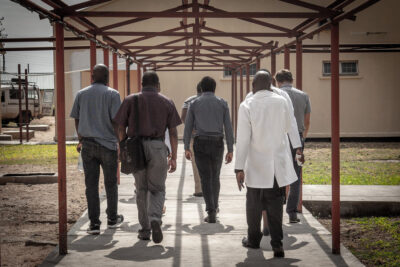Main content
When Ebola hit West Africa for the first time just five years ago, it was a little known, but much feared lethal disease. With no cure or vaccine available it could kill over 50% of people infected.[1] This, and the fact that people were unfamiliar with the disease and the way it spread, is why the disease was able to sweep across the region infecting more than 28,600 people and killing 11,300 of them. Upon the recommendation of the European Medicines Agency’s scientific committee to recommend the approval of conditional market authorization for the world’s first Ebola vaccine (in October 2019), which has been successfully deployed as an investigational product to fight the now waning outbreak in the Democratic Republic of the Congo, the World Health Organization formally announced its prequalification in mid-November. In less than half a decade, Ebola has gone from being nearly a death sentence to a vaccine-preventable disease.
The significance of this is two-fold. Firstly, national regulatory bodies can now choose to expedite their own approval for the vaccine, just five years after the West Africa outbreak, whereas the whole process can normally take well over a decade. And secondly, it is a vaccine against a disease that predominantly impacts some of the poorest communities in the world: the type of vaccine that would not traditionally attract major investment from pharmaceutical companies.

Its ability to clear these two hurdles is in part due to the work of Gavi, the Vaccine Alliance based in Geneva, which seeks to increase access to new and underused vaccines in low-income countries. At the end of the West African outbreak, Gavi sent a signal to the market that it would be there to purchase vaccines by committing to make up to USD 345 million available for Ebola vaccines. Then this particular vaccine was made available through an Advance Purchase Commitment agreement signed between Gavi and the vaccine manufacturer, Merck, in 2016. Gavi offered a USD 5 million pre-paid commitment to Merck in exchange for doses of the vaccine once it was licensed, under the condition that Merck would make a stockpile of investigational doses available for outbreak response as well as some regulatory requirements. It is these doses that have helped protect over 254,000 people against Ebola in DRC. [2]
This type of novel approach is indicative of the unique way that Gavi takes on the challenges that exist in increasing access to vaccines. Since 2000, the Vaccine Alliance has been helping protect some of the world’s most vulnerable children against deadly and debilitating diseases by leveraging innovative partnerships, technologies, and financing mechanisms.
Gavi’s inception
In the late 1990s, new and underused vaccines were not reaching those people most in need of them because new vaccines were made in low volume for high priced markets and therefore, most vaccines were simply not available at prices that their countries could afford. For example, in 2000, hepatitis B infections were killing more than 900,000 people a year, the majority in developing countries. But even though a highly effective vaccine had been available in wealthy countries since 1982, only a minority of low-income countries had so far introduced it. At the same time, global coverage of routine immunization was also plateauing, with more than 30 million children in the world’s poorest countries not being fully immunized even with the basic vaccines. Gavi’s strategy was to bring together key players at the global and local level – country governments, UN agencies, and civil society organizations – to address the major mismatch between the people who had access to vaccines and the people who could benefit from them the most. By harnessing the financial resources and expertise of these different partners, Gavi aimed to increase the affordability and accessibility of life-saving vaccines.
Sustainability goal
The most important partners within this Alliance are the implementing countries themselves. A cornerstone of the Gavi approach is that the organization works together with governments to build systems that they can sustainably finance well into the future, independently of Gavi support. The Gavi model requires all countries, no matter how poor, to contribute some proportion of the cost of the vaccines that they introduce through Gavi. As a country’s economy grows, as measured by their gross national income per capita, so too does the proportion that they pay, until it reaches a point of transition where the government has five years to fully fund its vaccine programmes. So far, 15 countries have transitioned out of Gavi support, with three more expected by the end of 2020.
The market shaping goal
Addressing the affordability side involves leveraging predictability of demand and economies of scale to secure lower vaccine prices. Gavi purchases vaccines for half of the world’s children and secures long-term funding from donors, helping create the visibility of demand and reducing the risk of investment for manufacturers. This helps to incentivize manufacturers to sustainably produce vaccines at prices that these countries can afford. And it works. As of 2018, it cost only USD 27 to immunize a child with a full course of basic vaccines in a Gavi-eligible country, compared to USD 1,300 in the US. It has helped to build healthier vaccine markets serving low-income countries: the number of manufacturers who supply Gavi with affordable vaccines has grown from five in 2000 to seventeen today, now that there is a viable developing country market.
Every dollar invested in vaccines yields usd 54 in wider societal benefits.
The systems goal
Yet accessibility to vaccines relies not just on the affordability of the vaccines themselves, but on having strong systems in place to deliver them. This is where local and private sector partners play a crucial role in the work of the Alliance. Worldwide, 19.4 million children are still missing out on some vaccines: many of them in remote rural communities, urban slums, displaced communities or areas of conflict. [3] Gavi works with the private sector to harness new technologies that can address these bottlenecks. In Rwanda and Ghana, for example, fleets of autonomous drones are now being routinely used to avoid stockouts by delivering vaccines to communities across both countries when supplies are low or when there is unexpected demand. Developed by California-based technology company Zipline, and with support from the UPS Foundation and Gavi, these networks are supporting millions of people, increasing the reach of health services and reducing waste at the same time.
Impact
Since 2000, Gavi has helped protect more than 760 million children with vaccines against a range of diseases, and in doing so has prevented more than 13 million deaths. Coverage with the most basic vaccines has increased from 59% to 81% in Gavi-supported countries. [4] This has paid dividends not just in terms of lives saved but also in terms of helping to boost economies. In a Gavi-supported country, every dollar invested in vaccines yields USD 54 in wider societal benefits, [5] and since 2000 this has translated into more than USD 150 billion in economic gains. All this makes vaccines one of the most cost-effective public health interventions ever. At the same time, vaccines bring us closer to the goal of Universal Health Coverage, by acting as a platform that helps to strengthen primary health care, because vaccines don’t deliver themselves. With vaccination comes infrastructure, supply chains, cold storage facilities, trained health care workers, community outreach, data services, disease surveillance, and much more. So, when communities get access to vaccination it puts these people on the map, and it is often not long before they also get access to a host of other critical services.
Gavi 5.0
Ultimately, Gavi is built on the philosophy that no-one should die of a vaccine-preventable disease, regardless of wealth, geography or gender. Yet every year 1.5 million people still do. [6] Reaching those still missing out will prove increasingly challenging, as population growth, rapid urbanization and climate change continuously move the goalposts. As will the unprecedented migration we are seeing with a record 70 million displaced people recorded last year. That is why Gavi’s new strategy, its fifth, covering strategic period from 2021-2025, called Gavi 5.0, is prioritizing communities with zero dose children (children not received any routine vaccine doses) who have historically missed out on vaccines. It also recognizes the need to put gender more at the centre of our programmatic planning, to ensure that communities are engaged and to offer tailored support not just at the national level but also sub-nationally. This approach aims to reach an additional 300 million children by 2025, saving up to 8 million more lives. But also built into this plan is an understanding that many of the greatest global health challenges we will face are those that we cannot plan for. Climate change, antimicrobial resistance, and emerging infectious diseases pose an ever-evolving risk. As the threats to our health become increasingly globalized and increasingly unpredictable, the Vaccine Alliance provides a valuable opportunity to get a multitude of stakeholders around the same table. This has already enabled Gavi to help protect an entire generation of children. Efficiency, innovation and collaboration will be the names of the game going forward, to help us make further progress, protect the next generation, and ensure that by 2030 no one is left behind.
So far, 15 countries have transitioned out of Gavi support.
References
- Kucharski A, Edmunds J. Case fatality rates for Ebola virus disease in West Africa. Lancet 2014; 384(9950):1260. Available from: https://doi.org/10.1016/S0140-6736(14)61706-2
- World Health Organization. Ebola virus disease Democratic Republic of the Congo: external situation report 68/2019. https://www.who.int/publications-detail/ebola-virus-disease-democratic-republic-of-congo-external-situation-report-68-2019. [Accessed November 26, 2019].
- World Health Organization. Immunization Coverage. https://www.who.int/news-room/fact-sheets/detail/immunization-coverage [Accessed October 27, 2019].
- World Health Organization. Immunization, vaccines, and biologicals. https://www.who.int/immunization/monitoring_surveillance/data/en/ [Accessed October 27, 2019].
- Immunization Economics.org. Decade of Vaccine Economics: return on investment. http://immunizationeconomics.org/dove-roi [Accessed October 27, 2019].
- World Health Organization. Immunization. https://www.who.int/news-room/facts-in-pictures/detail/immunization [Accessed October 27, 2019].



















































